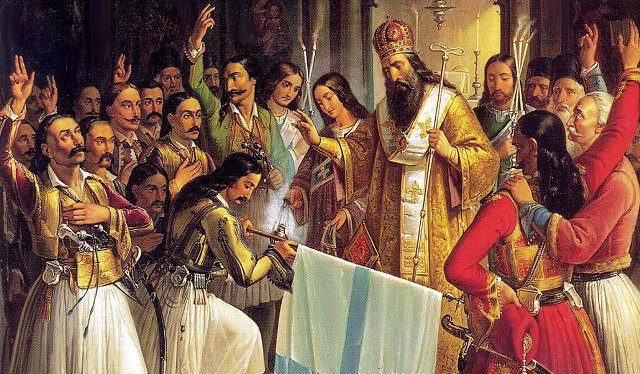
One of the most well-known paintings of the Greek War of Independence is undoubtedly the one painted by Theodoros Vryzakis in 1865 depicting Metropolitan Palaion Patron Germanos, known also as Germanos III of Old Patras.
In the iconic image, Germanos is shown raising the flag of the revolution in the Agia Lavra Monastery and blessing the beginning of the Greek uprising on March 25, 1821.
Historians date that initial meeting to March 13, and the reason Greeks later chose March 25 as the date of their revolutionary struggle is due to the feast of the Annunciation of Virgin Mary, the most important figure of the Greek Orthodox Church.
The Greeks wanted to link their liberation from the Ottomans with this holy day, thus, Greeks and Orthodoxy would remain inextricably connected.
The Metropolitan Palaion Patron Germanos was born in Dimitsana, Arcadia, on March 25, 1771. His secular name was Georgios Kozias, son of Ioannis Kozias who was a jeweler.
The life of the holy man, Germanos III of Old Patras
He received his education at the school of his native village and then at Argos, where he became a clergyman and served as deacon of Metropolitan Iacovos.
He then left for theological studies in Smyrna in 1797, where he was employed at the Bishopric by Metropolitan Grigorios.
When Grigorios became Patriarch in 1797 he took Germanos with him and promoted him to Archdeacon of the Patriarchate, where Germanos completed his religious studies and general education.
Germanos served as Archdeacon (1800-1806) and then as Protosyngellos at the Metrolopis of Cyzicus, where he was serving when he was elected Bishop of Patras in 1806.
His charisma made him Metropolitan of Patras. He was appointed a Synod member in Constantinople where he stayed for another three years (1815-1818).
Palaion Patron Germanos’ Involvement with the Filiki Etairia
When he returned to Peloponnese, he became a member of the “Society of Friends” (Filiki Etairia), a secret group of prominent people who were seeking independence from Ottoman rule for the Greek nation.
He was introduced to Filiki Etairia by Ioannis Vlassopoulos, Consul of the Russian Empire at Patras. Palaion Patron Germanos started a secret campaign to raise money for the revolution.
On March 13, 1821, a Sunday, Palaion Patron Germanos blessed the standard during the liturgy at Agia Lavra Monastery in Achaea, and on March 25 1821, blessed the fighters at Agia Lavra and hoisted the flag of the Greek War of Independence in Agios Georgios Square at Patras.
In December 1822, after the Greek rebels achieved some victories against the Ottomans, the political leaders sent Germanos to Italy on a mission to obtain aid and support for the war effort from the Pope and the European Congress at Verona.
However, the Metropolitan’s stay in Italy was fruitless, because the papal representatives asked Palaion Patron Germanos for the Greek Church to unite with the Catholic Church under the Pope, so he returned to Greece without even meeting with the Pope.
Some historians question Germanos’ role in the War of Independence
In his memoirs, however, Germanos did not mention a doxology either at Agia Lavra or Vostitsa, and did not even mention the swearing-in ceremony he held at Agios Georgios Square in Patras, perhaps so that he would not seem to be boasting, or because he did not consider it important.
This has caused some historians, who generally question the role of the higher clergy in the Revolution, to cast doubt on the role of Plaion Patron Germanos in the War of Independence.
After he returned to Greece from Italy (June or July 1824) Greece was liberated and a minor civil war had already started.
Palaion Patron Germanos played a conciliatory role in the feuds among the Greeks who wanted political powers. He made the mistake of defending more strongly (perhaps on grounds of origin) the Achaean chieftains.
As a result, Ioannis Gouras had him arrested in 1825 but then set him free.
After that, Metropolitan Germanos moved to Nafplio where he was appointed member of the Foreign Affairs Committee of the Third National Assembly.
He died on May 30, 1826 and was buried with honors in Nafplio. Later his remains were transferred to Dimitsana, his native village.
See all the latest news from Greece and the world at Greekreporter.com. Contact our newsroom to report an update or send your story, photos and videos. Follow GR on Google News and subscribe here to our daily email!



